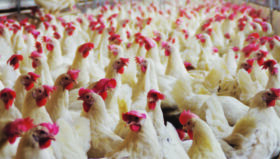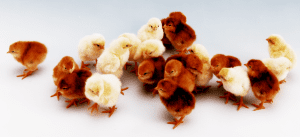By T.J. Gaydos
Producing high-quality chicks is critical to the success of any broiler program, but it is even more important in an antibiotic-free (ABF) program. The hatchery is the perfect environment for the incubation of eggs and, consequently, bacteria and mold. This makes hatchery sanitation a very high priority in ABF production systems because of the inability to use antibiotics in the hatchery or later in production.

Chick quality can be divided into two categories:
- microbiologic
- chick vitality
The reality is many of the processes that impact these two categories are often intertwined but can be generally separated into
- sanitation practices
- setting/hatching practices
It is not helpful to set specific objective benchmarks for an individual hatchery without understanding its specific challenges. The hatchery manager must realize that the end product is a healthy, robust chick; therefore, benchmarks and numerical goals for the individual hatchery, breed, and flock age need to be established.
There are a host of measurements that can be performed and data that can be collected; however, it only makes sense to collect only information that will be used to make decisions. It is easy to over-collect and under-utilize data.
Hatchery sanitation
Bacterial contamination
Hatchery sanitation starts at the breeder farm. Eggs are a significant source of contamination in the hatchery; consequently, floor eggs should not be brought to the hatchery. If they must be hatched for egg flow needs, it is essential to at least segregate them from the regular egg flow throughout the process. It is imperative to send a clean egg pack to the hatchery (transport and store the eggs at proper temperatures and humidity). Once the eggs are at the hatchery, the focus is on proper storage, incubation, and hatching.
Monitoring sanitation
The risk of multiplying bacteria in the hatchery is high. Hatchery equipment can be difficult to clean, there are sufficient nutrients to support microbial growth, and the environment is perfect for incubation. Developing a program to monitor the cleanliness of the hatchery is a critical step in managing sanitation. The whole hatchery must be regularly cleaned and disinfected, and the most effort should be spent on chick contact surfaces.
Egg flats must be clean and dry before returning to the breeder farm. Hatcher baskets must be clean and dry before eggs are transferred. The tray wash machine should use a detergent and disinfectant to remove and sanitize the trays (the water temperature should be 140oF). A disinfectant with residual efficacy should be used after the tray wash. Too low of a temperature will encourage bacterial growth, and too high a temperature can damage the baskets.

When using an in ovo vaccination system, it is essential to clean and disinfect the machine after every use and prepare it for the next transfer. Chick belts, counters, chick baskets, hatchers, and setters are all areas that can harbor pathogens. Wet areas are also at risk for harboring disease: wet bulb thermometers, humidification equipment, and tray washers. All these areas should be regularly checked for cleanliness by traditional microbiology or rapid ATP testing.
It is important to monitor the hatchery air quality on a regular basis to ensure the level of bacteria and fungi is not too high. This is most effectively accomplished by placing air plates in key locations for air movement such as clean hatchers and setters and their respective halls, and plenums. The areas where vaccines are stored, mixed, and prepared should be surgical suite clean.
Hatching practices
Chick vitality
A high-quality, active chick is one of the keys to program success. The actual profile used to hatch that bird is a mixture of breeder flock profile, hatchery equipment, climate, and experience. When evaluating a hatchery and a hatching program, it is best to start at the endpoint and work backward.
Managing chick comfort in the holding room is vital to set the chicks up for success on the farm. The chicks will tell you if they are too hot or too cold and if they have too much or too little airflow. This is determined by experience and monitoring behavior.
Tracking chick rectal temperatures is a useful way to check comfort. Remember that a small animal can change their body temperature from ideal to hyper- or hypothermic extremely quickly. On average, 103.5oF is a good benchmark for chick internal temperature. Moving backward through the process, evaluate the vaccine spray cabinet to ensure chicks are getting the proper vaccines at the proper rate.
The next critical opportunity to monitor chick vitality is when chicks are being separated from hatch debris. The volume of chicks passing through the site allows for rapid evaluation of the flock. In this area, it is important to check for open navels, strings, red hocks, green chicks, dirty chicks, and general appearance and behavior.

Hatch debris
The egg should be pipped and broken almost exactly in half. The debris should have minimal meconium, yolk stains, and should not smell bad. Excess meconium is an indication that the hatch window is prolonged, and the chicks spent too much time in the machine before pull.
When eggshells are crushed in one’s hand they should break, but the membrane should remain intact. If the membrane also breaks, it is a sign that the chicks were potentially overheated, incubated too long, or humidity was too low.
Chick yield
One of the most useful measures of the setting process is chick yield, which is the weight of the chick at hatch compared to the weight of the egg set. Chicks with a low yield were set with a high temperature or low humidity or were hatched for a long time before being removed from the hatcher. Chicks with a high chick yield are a result of the opposite: low temperature and high humidity incubation or did not spend enough time in the hatcher post-hatch. The ideal chick yield depends on the breed of chicken and the individual hatchery, but 67-68 % yield is a good benchmark.
Breakout
Analyzing hatch debris is a crucial tool for understanding setting and hatching efficiencies. Embryo mortality is variable but tends to follow a consistent pattern. The majority of embryo mortality is early (1-7 days), with little mortality in the middle (8-14 days), and the second increase in embryo mortality occurring from 15-18 days. Results should be recorded, and a standard developed for the hatchery. Deviations from this standard should be investigated.
When aiming to improve the data collection process, focus on building a program that prioritizes the most useful information. Breakouts and chick yields are two of the most meaningful tests to modify the hatching process. Sanitation checks and monitoring of disinfectant levels at critical sanitation steps are valuable to improve hatchery quality. When all the pieces come together, high quality egg pack, sanitation, and excellent hatchery management, the result is a high-quality chick ready to succeed on the farm.
















